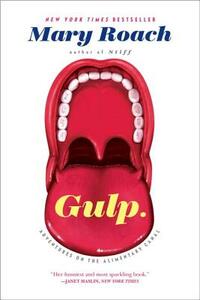You need to sign in or sign up before continuing.
Take a photo of a barcode or cover
A little disappointed on this one. As expected, the wit and attention to detail are there, but "Gulp" lacks the balance between science and humor that made "Stiff" such a great read. The stories also focus too much on either debunking or highlighting quackery and pseudoscience.
A quarter of this book is spent talking about poop. The writing was done very well. I need to find more books by this author. I love books like this where you just learn a ton of crap (pun intended) about stuff.
Notes:
Dogs stick their heads out the window while riding not to feel the wind but to smell all the things that are passing by. The dog's sense of smell is a thousand times more sensitive than a humans.
People can smell on the inside of their mouths in the back of their throat.
A typical human sniff has a duration of 1.6 seconds.
Cats will tend to be either mousers or birders but not both.
The cat is a true carnivore and doesn't and shouldn't eat plants.
Lobsters taste with their antennas just like flies taste with their feet.
There are taste receptor cells in the gut, the upper esophagus, and the voice box, but the taste buds are the only ones that report to the brain. Those other taste receptors are also thought to trigger hormonal responses or defense mechanisms.
Animals have cultural food preferences.
Organs in general are the most nutritionally given foods on Earth. Lamb spleen have as much vitamin C as an orange. That's how those cultures who live way in the north such as the Inuits in Alaska are able to get all their vitamins and minerals even though they don't really eat fruits and vegetables. It's because of organs from animals. however, organs are unappealing because they remind us of what we have in common with animals.
Until kids are about two you can get them to try pretty much anything. By the time children are 10 years old they eat what people eat around them. People like what they eat rather than eat what they like. If people try a particular food enough times they will grow to like it.
I think if we chew our foods a lot more than we do then our poop won't smell as bad.
One of the worst odors in the world is incubated saliva.
Saliva heals wounds faster.
Sticky rice mochi from Japan kills about a dozen people a year.
The crunch of a chip is a tiny Sonic boom your mouth.
Crispness and crunch is the body shorthand for healthy.
Anal violins are sick.
Elvis spent a half hour to an hour on The Can. Imagine if he lived today with a cell phone.
Notes:
Dogs stick their heads out the window while riding not to feel the wind but to smell all the things that are passing by. The dog's sense of smell is a thousand times more sensitive than a humans.
People can smell on the inside of their mouths in the back of their throat.
A typical human sniff has a duration of 1.6 seconds.
Cats will tend to be either mousers or birders but not both.
The cat is a true carnivore and doesn't and shouldn't eat plants.
Lobsters taste with their antennas just like flies taste with their feet.
There are taste receptor cells in the gut, the upper esophagus, and the voice box, but the taste buds are the only ones that report to the brain. Those other taste receptors are also thought to trigger hormonal responses or defense mechanisms.
Animals have cultural food preferences.
Organs in general are the most nutritionally given foods on Earth. Lamb spleen have as much vitamin C as an orange. That's how those cultures who live way in the north such as the Inuits in Alaska are able to get all their vitamins and minerals even though they don't really eat fruits and vegetables. It's because of organs from animals. however, organs are unappealing because they remind us of what we have in common with animals.
Until kids are about two you can get them to try pretty much anything. By the time children are 10 years old they eat what people eat around them. People like what they eat rather than eat what they like. If people try a particular food enough times they will grow to like it.
I think if we chew our foods a lot more than we do then our poop won't smell as bad.
One of the worst odors in the world is incubated saliva.
Saliva heals wounds faster.
Sticky rice mochi from Japan kills about a dozen people a year.
The crunch of a chip is a tiny Sonic boom your mouth.
Crispness and crunch is the body shorthand for healthy.
Anal violins are sick.
Elvis spent a half hour to an hour on The Can. Imagine if he lived today with a cell phone.
my favorite mary roach. i have a signed copy that says “glassily yours.”
funny
informative
fast-paced
All the things you never wanted to know about the human digestive system, from the fantastic powers of digestive enzymes, to the curative properties of fecal transplants! And a slightly disturbing overview of the wild and frequently unethical experiments scientists have historically conducted to learn about the digestive system. I learned a ton, and the book was very easy to read. Just…don’t read this if you have a weak stomach
I preferred Fuzz. There is only so much about farts and poop that a person can take in before you teach your threshold.
funny
informative
lighthearted
fast-paced
First, Mary Roach is such an entertaining writer - she made the "ick factor" of this book amusing. I also learned an incredible amount about my body (saliva, digestion, and rest of that "ick" part). There were definitely chapters that I was hoping the person next to me on the train wasn't peeking over my shoulder, but I'm glad I read this!
I picked up Gulp because Mary Roach’s writing was recommended for fans of Lab Girl and others who enjoy science writing. It did not disappoint. Roach takes her readers on a light hearted trip through the digestive system, investigating history, current research and odd human behavior along the way. Each chapter examines a different topic so it doesn’t get too bogged down in detail. I’m always writing pretend units of study for imagined classes I’d like to teach: this book would be excellent for a cross-curricular biology/literature class. With her playful yet earnest tone, Mary Roach finds her place alongside Stephen Jay Gould on the shelf for approachable scientific writers.
Gulp is one of the most disgusting books I have ever read. Disgustingly brilliant and fascinating! Mary Roach is the queen of taking taboo subjects (death, sex, war, the alimentary canal, etc.) and breaking them down into compulsively readable books that everyone can appreciate. Gulp takes a look at everyone's favorite organ, the alimentary canal (I mean who doesn't love the poop emoji?!), and takes a deep fascinating look at it. There is a chapter on the properties and uses of spit, a chapter on constipation (learn more about Elvis!), a chapter on on overeating or over chewing, studies on competitive food eaters. Everything you could ever want to know about what happens to food between when it enters your mouth until it gets shit out (so much about poop!), is covered in this fascinating nonfiction book. Read it! Soo interesting and hilariously (yet reverently) written.



